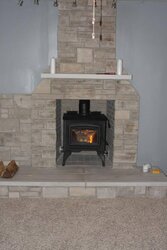in a few weeks, i will be embarking on a complete basement remodel (seismic retrofit, changing layout of walls, insulating the concrete floor and walls of the foundation, etc). we have a jog in the foundation wall that used to house a ZC fireplace that i ripped out during this project (https://www.hearth.com/talk/threads...t-n-glo-northstar-fireplace-with-pics.149631/ - look for the 3rd picture to see the basement area).
originally, we had planned to close off this old fireplace area and frame over it. now, i'm getting the itch to put in a stove there.
i've come to the conclusion that only a BK or an NC-30 makes sense (i either want a cat with incredible burn times, or a tube stove that people love and is cheap).
here are the stats:
basement SF: ~700 in 3 or 4 rooms
chimney run: ~25ft
upstairs will be easily heated by the northstar
floors to be insulated with 1" foam, then subfloor, then carpet
concrete walls to be insulated with sprayed on closed-cell foam to 2" (should be R15 and air sealed)
cripple walls insulated to R13
no concrete will be exposed in the final basement - only drywall and carpet
HVAC is through a heat pump + electric furnace
mild maritime environment
i read through this thread (https://www.hearth.com/talk/threads/blaze-king-king-on-6-chimney.56497/page-2) regarding the use of 6" chimney. if that size actually works, is this an acceptable product (http://www.homedepot.com/p/DuraVent...-Wall-Chimney-Stove-Pipe-6DP-36SS/100144227)?
unfortunately, with last year being our first year burning wood (part time), we didn't experiment a whole lot with heating the whole house options. we did turn on the re-circ fans on the HVAC system once or twice and it seemed to cycle enough warm air down to the basement to make it tolerable (and that's in its currently insulated state, which is poor). but, i'm not sure how it would do in colder spells. also, i like the idea of not using electricity to heat, although i realize the breakeven cost is probably favored towards the recirc air vs stove.
anyway, i just wanted to get your opinions on which stove. we are expecting our first child in a few months, so keeping the house warm all day will be more important than it is for just the two of us. hence, the idea of a BK and 24hr burns sounds nice. plus, if we don't need to heat the upstairs, it seems like it would be a good fit. OTOH, using the nc-30 could be problematic due to spikes in temperature (highs, then lows) and it could possibly cook us out of the room (which is where i expect the future kids to hang out most).
thanks for reading the long-winded brain dump.
originally, we had planned to close off this old fireplace area and frame over it. now, i'm getting the itch to put in a stove there.
i've come to the conclusion that only a BK or an NC-30 makes sense (i either want a cat with incredible burn times, or a tube stove that people love and is cheap).
here are the stats:
basement SF: ~700 in 3 or 4 rooms
chimney run: ~25ft
upstairs will be easily heated by the northstar
floors to be insulated with 1" foam, then subfloor, then carpet
concrete walls to be insulated with sprayed on closed-cell foam to 2" (should be R15 and air sealed)
cripple walls insulated to R13
no concrete will be exposed in the final basement - only drywall and carpet
HVAC is through a heat pump + electric furnace
mild maritime environment
i read through this thread (https://www.hearth.com/talk/threads/blaze-king-king-on-6-chimney.56497/page-2) regarding the use of 6" chimney. if that size actually works, is this an acceptable product (http://www.homedepot.com/p/DuraVent...-Wall-Chimney-Stove-Pipe-6DP-36SS/100144227)?
unfortunately, with last year being our first year burning wood (part time), we didn't experiment a whole lot with heating the whole house options. we did turn on the re-circ fans on the HVAC system once or twice and it seemed to cycle enough warm air down to the basement to make it tolerable (and that's in its currently insulated state, which is poor). but, i'm not sure how it would do in colder spells. also, i like the idea of not using electricity to heat, although i realize the breakeven cost is probably favored towards the recirc air vs stove.
anyway, i just wanted to get your opinions on which stove. we are expecting our first child in a few months, so keeping the house warm all day will be more important than it is for just the two of us. hence, the idea of a BK and 24hr burns sounds nice. plus, if we don't need to heat the upstairs, it seems like it would be a good fit. OTOH, using the nc-30 could be problematic due to spikes in temperature (highs, then lows) and it could possibly cook us out of the room (which is where i expect the future kids to hang out most).
thanks for reading the long-winded brain dump.


